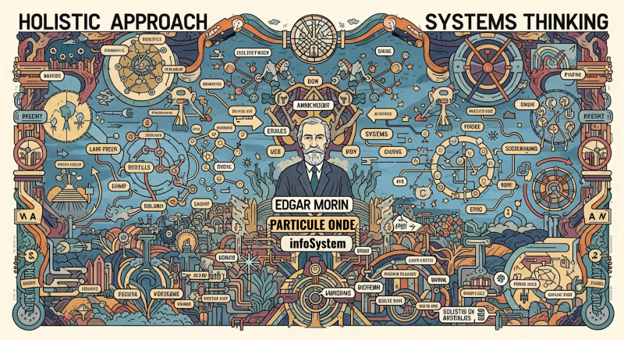In our interconnected world, understanding complex phenomena is paramount. Three powerful frameworks often come to mind: the Holistic Approach, Systems Thinking, and the Complex Thought of Edgar Morin. While sharing common ground, each offers unique lenses.
Understanding the core concepts
- Holistic Approach (Cape Town 1920) : More of a philosophical stance, holism asserts that the whole of something is greater than the sum of its parts. It emphasizes looking at situations in their entirety, considering all relevant aspects – social, environmental, economic, cultural – and their interdependencies, rather than isolating individual components. It’s about seeing the bigger picture.
- Systems Thinking (Palo Alto 1950) : This approach focuses on identifying the interconnected parts within a system, how they influence each other over time, and the emergent behaviors that arise. It uses tools like feedback loops, stocks, and flows to map dynamic relationships and uncover leverage points for effective intervention. It’s about understanding structure to predict and influence behavior.
- Edgar Morin’s Complex Thought (Paris 1980) : Morin’s work, often termed “Complexity Theory” or “Complex Thought,” integrates systemic ideas but goes further. He emphasizes inherent uncertainty, disorder, and the paradoxical nature of reality. Morin advocates for “re-linking knowledge” across disciplines, acknowledging that true understanding requires embracing contradictions, self-organization, and the continuous interaction between order and disorder. It’s about thinking about thinking in a complex world.
Where they converge: the similarities
All three reject reductionism, the idea that phenomena can be understood by simply breaking them down into isolated parts. They fundamentally agree that:
- Interconnectedness Matters: Everything is linked, and isolating elements leads to incomplete understanding.
- Emergence is Key: The whole creates properties that aren’t present in individual parts.
- Context is Crucial: Understanding a phenomenon requires considering its environment and interactions.
The nuances: where they differ
While harmonious, their emphasis sets them apart:
- The Holistic Approach is broader, acting more as a mindset or guiding principle for perception and consideration. It’s less about specific analytical tools and more about the attitude of comprehensive consideration.
- Systems Thinking often provides a more methodological toolkit for analyzing specific system structures (e.g., drawing feedback loops, identifying leverage points for intervention). It’s very much about the “how.”
- Edgar Morin’s Complex Thought adds a profound philosophical and epistemological dimension. He delves deeply into the nature of knowledge itself in the face of irreducible complexity, advocating for a way of thinking that embraces paradox and acknowledges the limits of objective knowledge, challenging disciplinary fragmentation at its root.
In essence, the Holistic Approach gives us the perspective to see the whole, Systems Thinking gives us the tools to analyze the connections, and Edgar Morin gives us the wisdom to embrace the inherent contradictions and uncertainties within that whole.
Understanding these frameworks empowers us to approach challenges with greater clarity and effectiveness.
What are your thoughts on integrating these approaches in practice?





